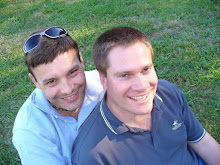Here's the third and final retrospective post about the South Island road trip I took in the Summer of 1995. It’s another of my Kodak-era travel adventures. In other words, every image in these posts was scanned from an ageing photo album. You’ll find the first post
here, and the second post
here. On 8 January, after three nights in Queenstown, my flatmate, Chris Ogg, and I drove over Haast Pass to Fox Glacier.
The drive through the remote Haast wilderness was wonderful. Lake Wanaka and Lake Hawea were at their best. We stopped to admire the view at The Neck lookout and again when crossing the famous Gates of Haast Bridge. That's the bridge below. I still vividly recall the craggy old-growth rainforest lining long stretches of coastal road in a verdant canyon. Our accommodation for the night was a motel at Fox Glacier.
We finished the day by visiting the Fox Glacier terminus. A short 1.5 km walk from the carpark along the river's gravel bed took us to its crumbling icy façade. The ancient slabs of iridescent blue ice were simply mesmerizing. I’ve read that the glacier was advancing a metre a week in 1996, the year after our visit. Sadly, in recent decades, thanks to climate change, it’s retreated almost a kilometre upstream.
The following morning, we made our way to the local airfield, hoping to score a helicopter flight over the Fox Glacier. Flights had been grounded for several days due to inclement weather, the same conditions we’d encountered in Milford Sound the previous day. I didn’t rate our chances as low-level clouds covered the coast.
However, we were in luck. The tour company told us flights had resumed. The glacier was in a cloud-free valley with perfect flying conditions reported at a higher elevation. We booked the first flight of the day. What a flight it was. We followed the Fox River towards the glacier's terminus, then rose over its craggy ice flows, séracs, and deep crevasses.
As we climbed, the scene below grew increasingly spectacular. Lingering coastal clouds quickly gave way to a stunning deep blue sky. The first photo above shows our view back down the glacier. Its icy mass descends 2,600 metres from the Southern Alps, flowing almost 13 kilometres towards the coast before finishing near the rainforest just 300 metres above sea level.
Our pilot landed on an icy plateau at the top of the glacier. We spent ten minutes or so walking on the pristine, dazzling white snow, snapping photos and soaking in the alpine scenery. However, we were in for one more treat. As the first flight for several days, the pilot wanted to briefly survey the neighbouring Frans Josef Glacier. We flew north along the alpine ridge and briefly circled the second glacier before returning to base.
From Fox Glacier, we drove up the West Coast as far as Greymouth. Here we took a brief detour so that I could see the house I'd lived in for the first four years of my life. As we rounded a corner on Freyberg Terrace, it came into view. The two-storey building with its distinctive grey roof was instantly recognizable. It looked exactly as I recalled it in photographs from my childhood.
Much to my surprise, the original street-level garage was still standing, along with the steep stairway leading up to the house. I vaguely recall a goat that we kept on the steep grassy slope below the house. It was the only viable option for keeping the grass under control. My aunt recently reminded me that it died while we were on vacation one year.
The third image of the house below was cleaned up using AI and Photoshop. The original file my aunt shared was very low-resolution. Yes, that's me in the middle on the front lawn. The final image was taken by Hamish when he visited Greymouth last month. It's amazing the house is still standing 60 years later.
We then drove over Arthur Pass to Christchurch where we stopped for the night. Along the way, we stopped again and again to soak in the alpine landscape, which included the dramatic Otira Gorge and its infamous winding road. These days, an impressive 445-metre-long viaduct carries the road up the valley floor. When it opened in 1999 it bypassed the "Zig-Zag", a series of hair-raising hairpin turns that had made this section of road notorious.
My father used to tell stories of how he and Mum successfully navigated these tight turns by driving their modest little Morris Minor in reverse up the then-unpaved gravel road. Incredibly, this car is still in the family, although it's no longer roadworthy. My grandmother bought it from my parents while they were living in Greymouth and kept it until she died in 1997. My cousin Carolyn has it parked in a shed out the back of her home in Christchurch.
Back to our road trip. Auntie Pam hosted us overnight on a makeshift bed on her sunroom floor. We then spent our final day in New Zealand exploring the highlights of Christchurch and the Avon River before making our way to the airport. Before we knew it, we were back in Sydney.















































